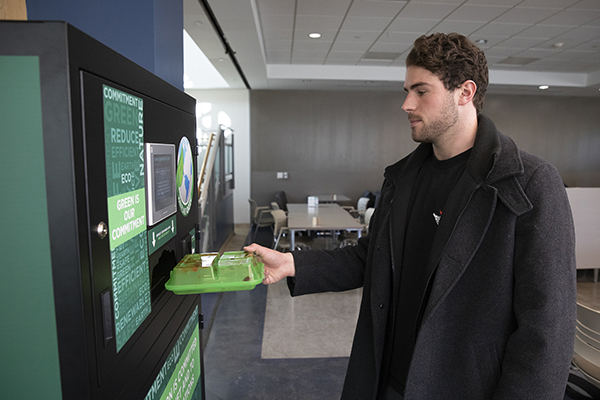From disposable to reusable, one meal at a time
New OZZI system a collaborative sustainability initiative

The OZZI system, now in place in Binghamton University’s dining halls — two in Chenango Champlain, two in Appalachian and one in College-in-the-Woods — allows diners to fill a reusable container with food and return the container after use. The diner simply puts the empty container into the OZZI machine and gets a token in return that can be redeemed for another reusable container.
It’s all about sustainability, according to John Enright, general manager of resident dining for Binghamton University Dining Services (BUDS).
“We were using a very high volume of compostable clamshell containers and students would get one of these to-go containers and then dine in,” he said. “We were invested in the compostable containers, but they were just getting thrown back into the landfill.”
In addition, the eco-friendly clamshell containers could not be composted due to the lack of municipal composting in the Broome County area, said Paul Zakrepine, Student Culinary Council (SCC) co-president.
So, when BUDS returned to plastic containers while looking for a more environmentally friendly option, there was criticism, prompting the decision to switch to OZZI, Zakrepine said.
“The OZZI system was actually in our sights ever since I joined the SCC in spring 2018, and even before then, because it was being used at several other universities,” Zakrepine said. “It was only when the SCC and administrators collaboratively decided to switch to plastic clamshell to-go containers instead of the eco-friendly ones that could not be composted that the system was decided upon.
“It was a collaborative choice between BUDS, SCC, Auxiliary Services and the student body,” Zakrepine said. “The SCC was involved in the push toward OZZI, then it transitioned to gathering student opinions on the system. The SCC sent out a mass survey to students living in residential halls and received over 1,800 responses — more than 80% of those in favor of the OZZI system.”
Throughout the process, the SCC continued to meet with BUDS and administrators to work out logistics, including presenting to resident assistants to encourage them to teach their residents how to use the OZZI system and promoting it to the student body through fliers, mass emails and ads on the screens in the MarketPlace.
“Res Life was a big help, as they sent out our surveys and advertisements through their listservs,” Zakrepine said. “BUDS made and distributed the fliers and television ads, which was very important in piquing student interest in the system.”
Use of the OZZI system is actually quite simple, Enright said. To start, every student with a meal plan was given credit for one reusable container.
Once they swiped through to get their first container, they were set, he said. “They have their container and go to any station and have it filled with the food of their choice. Then they can dine anyplace on campus.
“Once they’re done eating, they remove any significant amount of debris and bring it back to their dining hall, insert it into the OZZI machine and get a token for another container.”
So far this semester, about 3,000 containers have been filled and, of those, about 2,400 have been recycled in an OZZI machine. “There were a few times when a student didn’t get a token back,” Enright said. “About one or two out of 1,000 times, so we’re checking the machines’ calibration.”
As for the OZZI system, there was some investment up front, but it’s not about the cost. “It’s about sustainability,” Enright said. “That’s the purpose of doing it. We’re saving energy and becoming green.”
Zakrepine agrees, and is optimistic about the future. “I hope to see the use of the containers become a normal part of student life at Binghamton University and not just a short-lived trend,” he said. “The impact on the environment would be tremendous and I believe that it will become a normalized part of life for students here, but it will take some time to get used to this and to completely fine-tune the system.”

